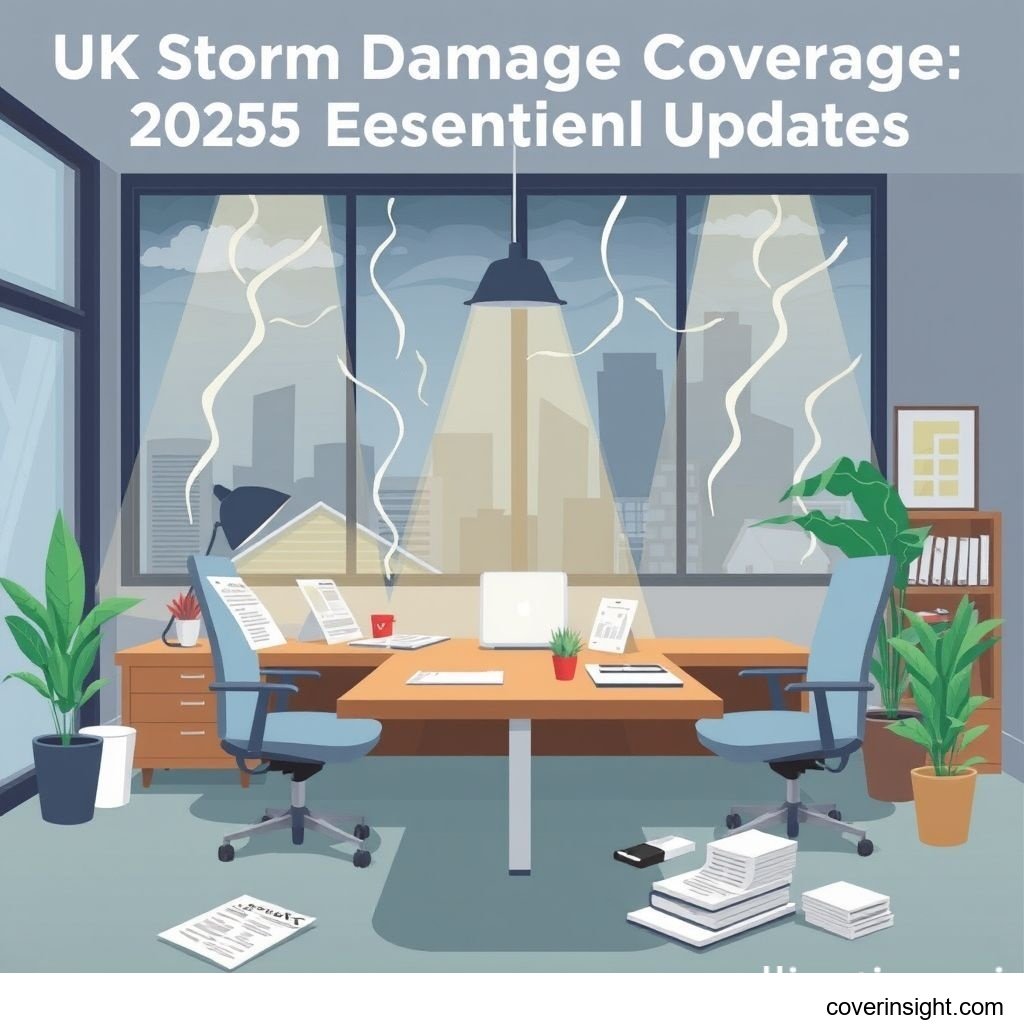UK Storm Damage Coverage: 2025 Essential Updates
Introduction
As we navigate 2025, the landscape of UK storm damage coverage is continually evolving, with a significant emphasis on consumer protection and, crucially, robust fraud prevention initiatives across Great Britain. These proactive measures are designed not only to safeguard insurers from fraudulent claims but also to ensure that honest policyholders receive fair treatment and that premiums remain as competitive as possible. Understanding these updates is paramount for homeowners, as they directly impact how you’re protected when the inevitable British weather takes a turn for the worse.
Coverage Details
Navigating the intricacies of your home insurance can feel like a bit of a maze, but when it comes to storm damage, knowing what’s covered and what isn’t can save you a world of grief.
What’s Included
Typically, storm damage coverage, often embedded within your standard home insurance policy, protects your property against damage caused by adverse weather conditions such as strong winds, heavy rain, hail, and snow. This can include:
-
Structural Damage: Repairs to roofs, walls, and foundations compromised by a storm.
-
Water Ingress: Damage caused by water entering the property due to storm-related issues (e.g., a dislodged roof tile leading to a leak).
-
Fallen Trees: Damage caused by trees or branches falling onto your property due to high winds.
-
Outbuildings: Coverage often extends to sheds, garages, and other outbuildings on your property, provided they are explicitly listed in your policy.
-
Alternative Accommodation: If your home becomes uninhabitable due to storm damage, many policies will cover the cost of temporary housing.
Based on my experience, it's wise to review your policy documents thoroughly. What might seem like a minor detail often makes all the difference when it comes to making a claim.
Common Exclusions
While policies are designed to offer peace of mind, there are common exclusions you should be aware of to avoid a nasty surprise:
-
Wear and Tear: Damage due to gradual deterioration of your property, rather than a sudden storm event, is almost never covered. An old, poorly maintained roof, for example, isn't likely to be covered if it simply gives way in a strong gust.
-
Flooding from Rivers/Sea: Standard storm coverage often excludes damage from flooding that originates from rivers, lakes, or the sea. For this, you typically need specific flood insurance, which may be a separate add-on.
-
Negligence: If damage occurs because you failed to take reasonable precautions to protect your property (e.g., leaving windows open during a storm), your claim could be rejected.
-
Frozen Pipes: While cold weather related, damage from burst pipes due to freezing often falls under a separate 'escape of water' section, not directly 'storm damage', though it's usually covered under a comprehensive policy.
-
Fences/Gates: Many policies specifically exclude damage to garden fences, gates, and sometimes even garden furniture, or offer very limited coverage for them.
It’s always prudent to check the fine print or consult with your insurer. You can also find comprehensive guides and insights on broader topics at Insurance Resources Global.
Cost Analysis
The price of your storm damage coverage, bundled within your home insurance, is influenced by a myriad of factors. Understanding these can help you potentially reduce your premiums.
Price Factors
Several elements play a part in shaping your insurance premium:
-
Location: Properties in areas prone to severe weather (e.g., coastal regions, areas with a history of flooding) or high crime rates often face higher premiums. For example, recent data from the Met Office indicates that the UK has experienced an increase in the frequency and intensity of named storms over the last decade, particularly affecting regions like Cumbria and parts of Scotland, which naturally influences insurance costs in those areas.
-
Property Type and Age: Older homes, particularly those with non-standard construction materials, can be more expensive to insure due to potential repair complexities. The size and value of your home also play a significant role.
-
Claims History: A history of previous claims, whether by you or previous occupants, can increase your premium.
-
Deductible/Excess: A higher voluntary excess (the amount you pay towards a claim) typically leads to a lower premium.
-
Security Measures: Installing approved security features like alarms, strong locks, and smoke detectors can sometimes reduce your premium.
-
Fraud Prevention Initiatives: While these initiatives are designed to keep overall industry costs down, the administrative overhead and technology investment might subtly be factored into base premiums. However, the long-term goal is to prevent the much larger costs associated with fraudulent claims from being passed on to honest policyholders.
Saving Tips
Keeping a lid on your insurance costs doesn’t have to feel like a losing battle.
-
Shop Around: Don’t just renew with your current insurer. Use comparison websites and get quotes from multiple providers.
-
Increase Your Excess: If you can afford to pay more towards a claim should the worst happen, increasing your voluntary excess will lower your monthly or annual premium.
-
Improve Home Security: Investing in approved security devices can make your home less risky in the eyes of insurers.
-
Pay Annually: If possible, paying your premium in one go is almost always cheaper than monthly instalments.
-
Bundle Policies: If you have multiple insurance needs (e.g., home and car), some insurers offer discounts for bundling them.
-
Review Your Sum Insured: Ensure you’re not over-insuring your property. The "sum insured" should reflect the rebuild cost, not the market value.
For more detailed advice on managing your home insurance, consider visiting GB Insurance Home.
FAQs
How much do fraud prevention initiatives cost?
While there isn't a direct line item for "fraud prevention" on your premium, the insurance industry collectively invests hundreds of millions annually in technology, data analytics, and expert teams to combat fraud. This investment is crucial; according to the Association of British Insurers, detected insurance fraud amounted to over £1.1 billion in 2021 alone. Without these initiatives, the cost of fraudulent claims would inevitably be passed on to honest policyholders through significantly higher premiums. The idea is that a robust approach to fraud prevention ultimately helps keep everyone's costs down.
What affects premiums?
Beyond fraud prevention, premiums are primarily affected by factors like your property's location (especially its exposure to storm risks), the age and construction type of your home, your claims history, the level of coverage you choose, and the security measures in place. Your chosen excess also plays a significant role.
Is it mandatory?
While home insurance, including storm damage coverage, isn't legally mandatory in the UK, it is a prerequisite for most mortgage lenders. Even if you own your home outright, going without it is akin to playing a risky game of chance, especially with the increasingly unpredictable British weather.
How to choose?
Choosing the right policy involves balancing cost with comprehensive coverage. Start by assessing your specific needs and the risks your property faces. Compare quotes from various providers, paying close attention to what's included and excluded, the excess amount, and customer reviews. Don't just go for the cheapest option; ensure it provides adequate protection for your specific circumstances. The Financial Conduct Authority offers excellent resources on choosing financial products.
Consequences of no coverage?
Without adequate storm damage coverage, you'd be entirely responsible for the often substantial costs of repairing your home following a storm. This could mean thousands of pounds out of pocket, potentially leaving you in a very sticky wicket financially. Consider the real-world impact: After Storm Babet battered parts of Scotland and England in October 2023, homeowners without proper insurance faced repair bills for structural damage, flooding, and extensive clean-up that ran into tens of thousands of pounds. For many, it would have been a financial catastrophe.
Author Insight & Experience
As someone living in GB, I've seen firsthand the havoc a good storm can wreak. It's not just about the property damage; it's the disruption, the stress, and the sheer effort involved in getting things back to normal. Having a robust storm damage policy isn't just about ticking a box for a mortgage lender; it's about genuine peace of mind. It allows you to keep a stiff upper lip, knowing that come hell or high water (literally!), you're protected, and you won't be left financially adrift when Mother Nature decides to show her true colours. It’s an investment in your future security, plain and simple.







Comments